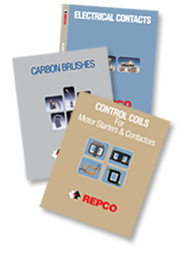Carbon Brush Spring Pressure
The force applied to a brush to hold it in contact with the commutator or slip ring is one of the most critical variables in brush performance. Brushholder spring pressure is the most common mis-rigged item in motors and generators, causing erratic performance, higher maintenance costs and expensive repair bills.
Brushes must be held firmly against the commutator to work properly. One might think that longer brush life is possible if the spring pressure is purposely set at a lighter pressure. Actually, the opposite is true. If the pressure is too light, imperfect contact and commutator threading may result. As springs weaken with age (rapidly if overheated), low spring pressure is a common problem. Brushes may momentarily separate from the rotating surface when struck by the irregularity. This ‘brush bounce’ interrupts current flow, leading to sparking and damage to the brushholder and commutator.
Brush wear increases when the pressure falls below the recommended lower limit. This wear is more severe than that caused by high pressures. Please note, however, that pressures that are too high or too low should not be tolerated. Excessive brush pressure can also result in higher frictional losses and needless wear.
Brush pressure is given in pounds per square inch (f/a) of brush cross-section. While it is often impossible to give the best pressure for any grade under all conditions of service, some limits of pressure can be recommended. Each grade has a limited range of pressure within which performance is considered optimum. The following is a basic guide for classes of applications:
| Class of Application | Brush Pressure |
| General Industrial | 2 to 4 lb/in2 (13.8 to 27.6 kPa) |
| Mill-type Motors | 3 to 5 lb./in2 (20.7 to 34.5 kPa) |
| Railway Service | 3.5 to 9 lb/in2 (24.1 to 62.1 kPa) |
Where vibration is severe, such as crane motors, truck motors and similar machines, the brush spring pressure should be about the same as for railway motors. When using metal-graphite brushes, the spring force must be adjusted to compensate for the heavier weight, depending upon whether the brushes are in the top or bottom holders of the machine.
In all cases, the manufacturer’s recommended brush pressure range is the surest way to the best results. Please contact Scott Tussey, manager of Carbon Brush Sales, at 800-822-9190, with any questions about recommended spring pressures for specific grades and applications or for more information about measurement instrumentation.

